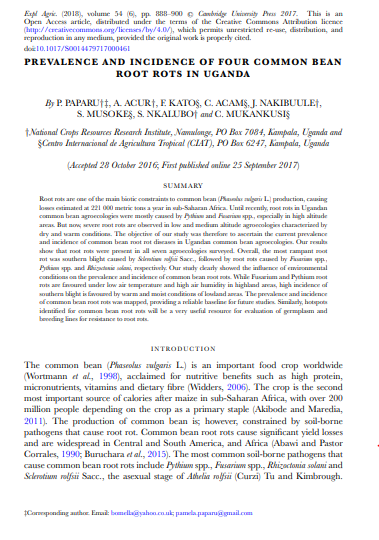Prevalence and incidence of four common bean root rots in Uganda
Summary
Root rots are one of the main biotic constraints to common bean (Phaseolus vulgaris L.) production, causing losses estimated at 221,000 metric tons a year in sub-Saharan Africa. Until recently, root rots in Ugandan common bean agro-ecologies were mostly caused by Pythium and Fusarium spp., especially in high-altitude areas. But now, severe root rots are observed in low and medium-altitude agro-ecologies characterized by dry and warm conditions. The objective of our study was therefore to ascertain the current prevalence and incidence of common bean root rot diseases in Ugandan common bean agro-ecologies. Our results show that root rots were present in all seven agro-ecologies surveyed. Overall, the most rampant root rot was southern blight caused by Sclerotium rolfsii Sacc., followed by root rots caused by Fusarium spp., Pythium spp. and Rhizoctonia solani, respectively. Our study clearly showed the influence of environmental conditions on the prevalence and incidence of common bean root rots. While Fusarium and Pythium root rots are favored under low air temperature and high air humidity in highland areas, high incidence of southern blight is favored by the warm and moist conditions of lowland areas. The prevalence and incidence of common bean root rots was mapped, providing a reliable baseline for future studies. Similarly, hotspots identified for common bean root rots will be a very useful resource for the evaluation of germplasm and breeding lines for resistance to root rots.
Open resource Download resource Access resource on external site

